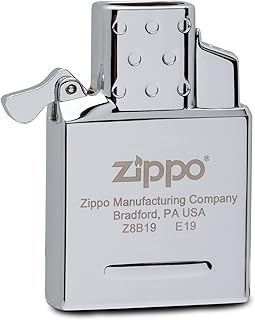The Anatomy of a Zippo Lighter: A Detailed Breakdown
The Zippo lighter is more than just a simple tool for creating a flame; it's an icon of American ingenuity and enduring design. To truly appreciate the Zippo, it's helpful to understand the parts that make it work. Here's a breakdown of the anatomy of a classic Zippo lighter:
Outer Shell (Case):
* Body: The iconic rectangular body of the Zippo is crafted from durable brass or stainless steel. It's known for its ruggedness and ability to withstand years of use.
* Lid: The hinged lid houses the flint wheel and striking mechanism, and it snaps securely shut to protect the internal components.
* Bottom: The bottom of the Zippo usually features the distinctive Zippo logo and branding, along with information about the lighter's production date and origin.
* Hinge: A sturdy brass hinge allows the lid to open smoothly and reliably.
Inner Mechanisms:
* Wick: Made of cotton or linen, the wick absorbs fuel and acts as a conduit for delivering it to the flame.
* Fuel Chamber: This internal chamber houses the lighter fluid and has a felt pad that absorbs the fluid and feeds it to the wick.
* Insert: The insert is the core functional element that sits within the outer shell. It includes the wick, fuel chamber, striking mechanism, and flint wheel.
* Striking Mechanism: A spring-loaded mechanism housed in the lid that propels the flint wheel against the flint, generating sparks.
* Flint Wheel: A toothed wheel that strikes against the flint to create sparks that ignite the fuel-soaked wick.
* Flint: A small, hard piece of stone that produces sparks when struck by the flint wheel.
* Fuel (Lighter Fluid): A highly flammable liquid that fuels the flame and is typically made from naphtha.
Additional Features:
* Windshield: The Zippo's iconic design features a wind-resistant design that protects the flame from gusts of wind.
* Filler Hole: A small opening located on the bottom of the lighter that allows you to refill the fuel chamber.
How It Works:
1. Fueling: The fuel chamber is filled with lighter fluid, which is absorbed by the felt pad.
2. Striking: When you flick the lid open, the striking mechanism launches the flint wheel against the flint.
3. Spark Generation: This friction creates sparks, which travel down the wick and ignite the fuel-soaked cotton.
4. Flame: The ignited wick produces a steady, reliable flame that can be adjusted by turning the wick adjuster.
Maintenance:
* Refilling: Regularly refill the lighter with Zippo lighter fluid.
* Wick Replacement: Replace the wick when it becomes frayed or worn.
* Flint Replacement: Replace the flint when it wears down or no longer generates sparks.
* Cleaning: Clean the insert with a cotton swab and lighter fluid to prevent clogging.
Conclusion:
The Zippo lighter's iconic design and simple, yet effective, internal mechanics have made it a trusted and beloved tool for generations. Understanding the anatomy of this enduring device allows us to appreciate its ingenuity, functionality, and timeless appeal.


